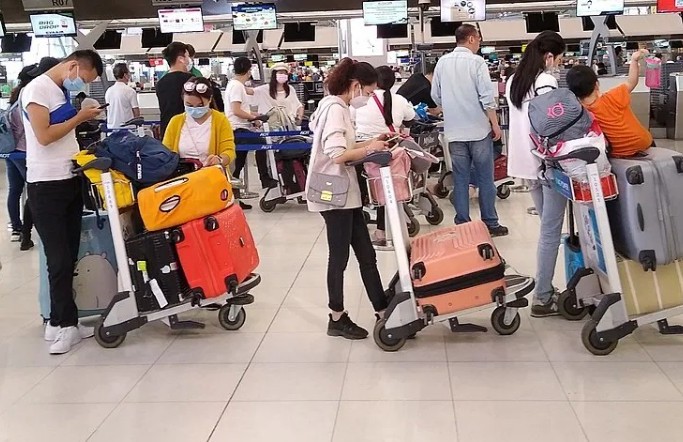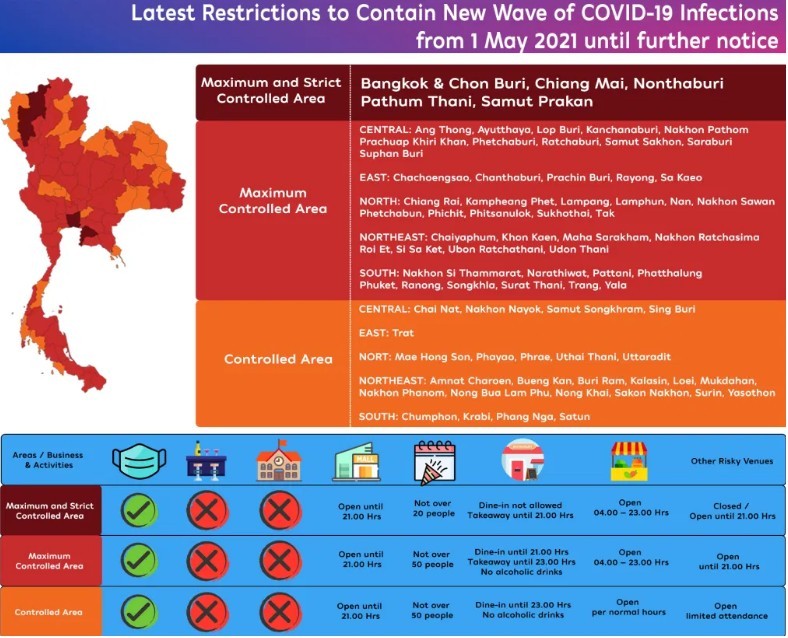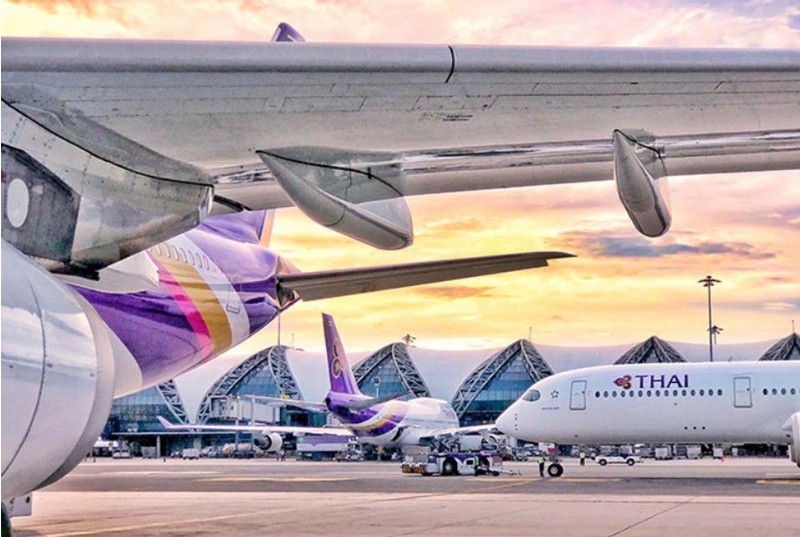
Updates for travelers regarding the Royal Thai Government’s announcement on strengthening the COVID-19 restrictions nationwide, while reinstating the 14-day quarantine for international arrivals.
Effective from 1 May, 2021, until further notice, Thailand’s latest restrictions to curb the new spread of COVID-19 infections are introduced as the country is preparing for the mass vaccination program, which is scheduled to start in June 2021.
Thailand has already procured 63 million doses of vaccine (61 million doses from AstraZeneca and two million doses from Sinovac) and is now in talks to procure 37 million more doses from other suppliers.
Preliminary rollout already started since late February in a number of Thai provinces, including Bangkok and four major tourist destinations – Phuket, Chonburi which includes Pattaya, Chiang Mai, and Surat Thani which includes Koh Samui, Koh Phangan and Koh Tao.

For now, and prior to the mass vaccination rollout, the Royal Thai Government recognizes the need to strengthen COVID-19 restrictions to curb local transmission.
The latest restrictions include reinstating the 14-day quarantine for international arrivals.
According to the Centre for COVID-19 Situation Administration (CCSA), all arrivals who hold Certificates of Entry (COE) issued on or later than 1 May, 2021, will be required to undergo quarantine for 14 days regardless of their nationality.
Meanwhile, travelers who have obtained their COE issued prior to 1 May, 2021, and arrive in Thailand before 6 May, 2021, will be quarantined for seven or 10 days, depending on their vaccination status.
Nationwide, the latest restrictions cover new COVID-19 zoning areas in Thailand.
Maximum and Strict Controlled Area or ‘dark-red zone’ comprises Bangkok and five other provinces – Chonburi, Chiang Mai, Nonthaburi, Pathum Thani and Samut Prakan.
Maximum Controlled Area or ‘red zone’ comprises 45 provinces: (region-by-region)
CENTRAL REGION: Ang Thong, Ayutthaya, Lop Buri, Kanchanaburi, Nakhon Pathom, Prachuap Khiri Khan, Phetchaburi, Ratchaburi, Samut Sakhon, Saraburi, and Suphan Buri.
EASTERN REGION: Chachoengsao, Chanthaburi, Prachin Buri, Rayong, and Sa Kaeo.
NORTHERN REGION: Chiang Rai, Kampheang Phet, Lampang, Lamphun, Nan, Nakhon Sawan, Phetchabun, Phichit, Phitsanulok, Sukhothai and Tak.
NORTHEARN REGION: Chaiyaphum, Khon Kaen, Maha Sarakham, Nakhon Ratchasima, Roi Et, Si Sa Ket, Ubon Ratchathani, and Udon Thani.
SOUTHERN REGION: Nakhon Si Thammarat, Narathiwat, Pattani, Phatthalung, Phuket, Ranong, Songkhla, Surat Thani, Trang, and Yala.

Controlled Area or ‘orange zone’ comprises 26 provinces: (region-by-region)
CENTRAL REGION: Chai Nat, Nakhon Nayok, Samut Songkhram, and Sing Buri.
EASTERN REGION: Trat.
NORTHERN REGION: Mae Hong Son, Phayao, Phrae, Uthai Thani, and Uttaradit.
NORTHEASTERN REGION: Amnat Charoen, Bueng Kan, Buri Ram, Kalasin, Loei, Mukdahan, Nakhon Phanom, Nong Bua Lam Phu, Nong Khai, Sakon Nakhon, Surin, and Yasothon.
SOUTHERN REGION: Chumphon, Krabi, Phang Nga, and Satun.
Measures in place all areas include mask mandate, closure of entertainment venues (pubs, bars, karaoke bars and massage parlours), and suspension of all in-person classes. In addition, shopping malls, department stores, community malls can open only until 21.00 Hrs., and are not allowed to hold any sales promotion activities.
Gatherings of more than 20 people are banned in the dark-red zone, while gatherings of more than 50 people are not allowed in the red and orange zones.
Dine-in at restaurants / food and beverage outlets in the dark-red zone is not allowed, and takeaway is allowed until 21.00 Hrs.
In the red zone, dine-in is allowed until 21.00 Hrs and takeaway until 23.00.00 Hrs. In the orange zone, dine-in is allowed until 23.00 Hrs. However, consumption of alcoholic beverages while dining in is not allowed.
Markets and convenience stores in the dark-red and red zones are allowed to open only between 04.00 – 23.00 Hrs., while those in the orange zone can open per normal operating times.
Other high-risk venues in the dark-red zone are either closed temporarily or open until 21.00 Hrs. with no attendance. In the red zone, these venues can open until 21.00 Hrs. with limited attendance. Meanwhile, those in the orange zone can open per normal hours with limited attendance.
People in the dark-red zone are urged to cancel or postpone interprovincial travel at this time, or must undergo strict screening measures, which may cause inconvenience.
Private sector organizations are encouraged to allow work from home options.





